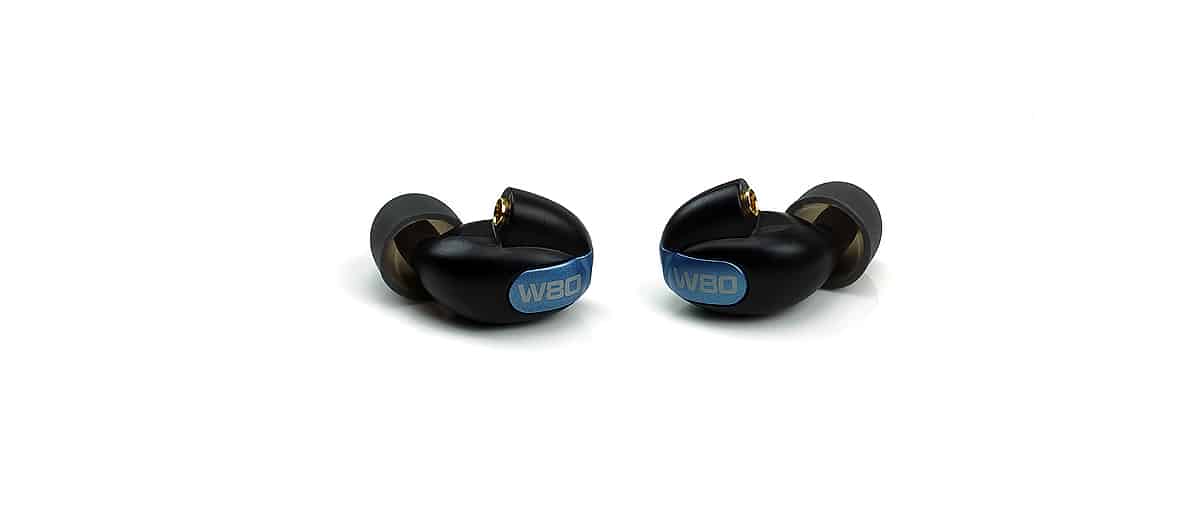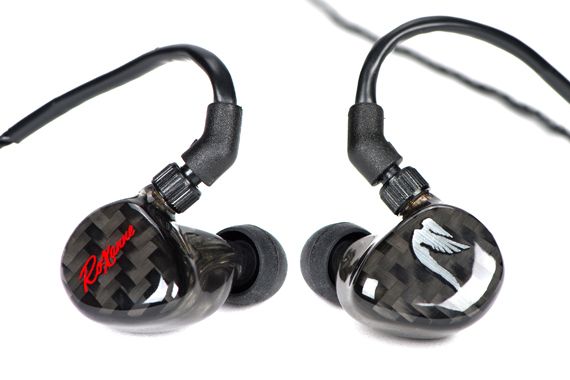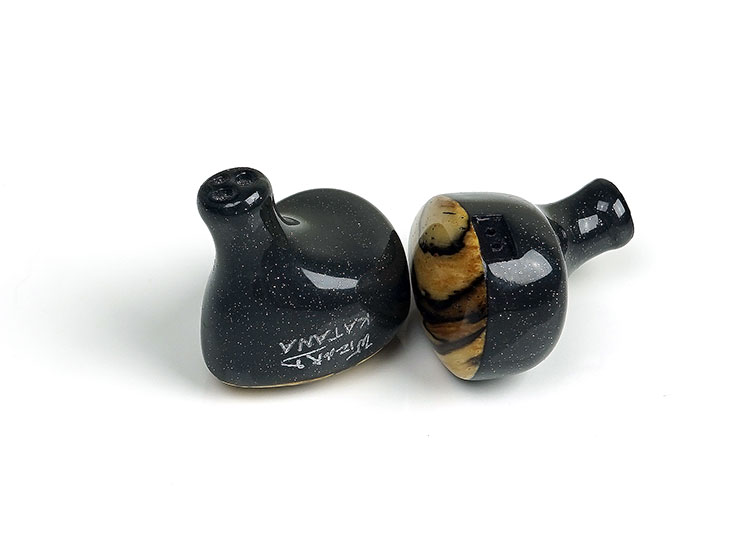Sound Impressions
Summary
The W80’s tuning is clearly towards the musical, smooth, and easy-going side of things. There is a slight mid-bass to lower mids bias providing a fairly full sound but otherwise, it is a very non-fatiguing tuning.
That tuning emphasis throws a little warmth over instrumental passages making them pleasing sounding but at the same time, a little lack of sub-bass presence robs a bit of power from their fundamentals a touch.
You get plenty of impact but it is not as deep as it could have been with those two full-range bass drivers. Using full-size bass BA drivers also slows down the speed a little so it is not as tight and quick sounding as smaller BA driver clusters but I do prefer them because of the slightly more natural sound they can deliver without bleeding all over the place.
The W80 has decent depth but better width and good layering in its presentation. Extension at either end is a little relaxed delivering a slightly intimate quality with its elevated midbass to lower mids pulling it in a bit over its sub-bass and brilliance presence.
Bass
The bass on the W80 reminds me of a classical BA tuning with more of a mid-bass emphasis at around 100Hz and a linear but very minute drop of not more than 2-3dB to around 1k.
In keeping with that tuning the W80’s sub-bass is more relaxed with a gradual drop off around 3-4dB slowly from 100Hz to 30hZ so it plays second fiddle to the mid-bass. As a result, you get a full sound, with some warmth due to the 100-250Hz mid-bass elevation but not necessarily a lot of sub-bass power.
The impact is good, EDM sounds excellent actually but deeper-sounding synth wave tracks, such as Dynatron do not quite have the clarity and control I would like because they draw a lot from a strong sub-bass mix.
The tiny drop from the mid-bass to the lower mids of around 2-3dB keeps lower key instruments or instrumental passages clear and with a good note body which I tend to prefer. Pleasingly, the W80’s mid-bass does not bleed into the mids however the transition is very smooth and somewhat linear in that respect so it does retain a bit of warmth into the lower mids.
Mids
Mid-range timbre on the W80 is very smooth, sibilant-free, and slightly to the warm side, especially on the lower mids. You will not get any nasty sharp overtones on instruments with the W80. Instead, you get a soft attack, a slight linger of decay, and a good lower mids body, particularly on guitar work, both rhythm and bass.
The W80’s control and detail are good though it is not on the level of the Katana which is pinpoint and very holographic sounding in its layering. The W80 trades that for a wide but easier slightly more intimate non-fatiguing presentation that remains in musicality.
There isn’t a huge mid-range elevation for vocals, perhaps a slight bump to create an element of separation and keep the vocals ahead of the stage a little but it is not the airiest. Vocals are pretty much in keeping with the general timbre of the mids on the W80 being fairly full sounding, smooth, and slightly soft but always sibilant-free.
Treble
The W80’s top end is relaxed and perhaps lacking in energy in the final octave and some necessary headroom. However, the detail is actually very good with a slight but smooth bump in the lower treble to bring out a little percussive sparkle and clarity but otherwise, this is very easygoing stuff. You could literally listen for hours with the W80 top-end and never get fatigued.
Given there are 4 drivers for the top end I was a bit surprised that Westone elected to let this one sit back a little because it takes a little air out of its brilliance region and pushes down a bit more on the mids.
It is not shelved down or dark sounding, it is actually quite natural sounding with a good body and nothing in the way of excessive peaking but it is not as airy as I could have hoped for.
Stock Vs ALO Reference 8
Aside from its better MMCX mechanism and non-slip stem compared to the Epic G2 cable the Reference 8 is a big tonal step up on the stock cable and once you compare the two I highly doubt you will change back again.
The Reference 8 cable delivers a more confident and dynamic signature with much better control on the low end. This is an impactful bass performance with the Reference 8, especially the sub-bass response which has a palatable presence that is more subdued on the Epic G2.
This is a more aggressive but deeply enjoyable pairing and I can understand why they went with ALO on this pairing because it doubles down on energy right up to the lower treble sparkle.
Synergy
Efficiency
The W80 is rated at an unearthly 5 ohms and 111dB sensitivity so the W80 will play out just fine with low voltage sources such as smartphones and weaker amp DAPs. In our multi-DAP testing, we found comfortable voltage or volume levels to be quite low when paired with the W80.
Without question, the W80 is designed to run out of low signal voltage amp sources such as modern-day Smartphones and DAPs. The Cayin i5 is proof positive of just how quickly you can get a signal into the W80 without barely moving the volume potentiometer.
The W80 can pick up an audible signal quicker than either the Shure SE846 or the Campfire Audio Andromeda but with a 111dB sensitivity rating, the 115dB Andromeda will get marginally louder once you hit normal listening levels.
Noise
That easy-to-drive equation though does not translate to a fussy sensitivity to noise such as you would find on Campfire Audio, Vision Ears, and Shure BA design IEMs, even with that low ohm rating. That surprised me in a good way.
Slight levels of hiss can still be detected on the likes of the Cayin i5, FiiO X5iii, and the Paw Gold DAP but it’s minute and not very distracting. I also got some irritating pops from the Mojo when jumping tracks using the W80 pairing on USB-DAC but no hiss. I would have no hesitations in these pairings though bar tonal preferences.
On portable amps such as the ALO Audio V5 portable tube amp, I got a really low noise floor which is a first for an IEM like this. Normally Andromeda would hiss like mad on this setup but not with the W80.
Mind you voltage levels were also quite aggressive on portable amps, even in a low gain mode so whilst noise control is impressive it is not really necessary to use one with the W80.
Pairings
ZTE Axon 7
Interestingly had a bit more treble sparkle than some high-end DAPs though it was a little strained and brittle in comparison to say the Mojo or the DX200.
This was a cleaner signature with excellent staging, plenty of energy, and a slightly subdued low end which suited the W80 quite nicely actually with the Reference 8 cable. The top end though lacked a bit of body compared to higher-end DAPs and more resolving amps.
Chord Mojo
The Mojo/W80 was very sensitive to pops on the Mojo during power on and off and changing tracks using USB DAC out.
This was probably the most resolving out of all the pairings with a punchy low-end and a cleaner more accurate mid-range compared to say the Opus#3. Certainly, more dynamic sounding than the Axon 7. This would be my go-to pairing if the detail was a must with the W80.
Aurender Flow
This was a good pairing as a DAC out experience. The volume control is excellent with a non-existent noise floor and no Mojo-style pops in FooBar.
What I like most about this tonal pairing is the attention to detail the Flow brings out on the W80. It pulls back a little on the mid-bass weight and puts more emphasis on articulation, particularly the treble performance as well as upping the spaciousness in the mids a little. The tonal quality is much less warm and more balanced sounding.
The only downside was the relative lack of dynamics and pop in the vocal performance of the Flow, something I mentioned before when I initially reviewed it.
The Bit Opus#3
Very smooth sound. The treble is not as glassy or brittle sounding as the ZTE Axon but the low-end gets a bigger lift so it sounds a little warmer. The vocals are superb actually, I really love the width you get on the W80 with a resolving DAP. It is still a low-to-mid-biased tonally smooth presentation but it seems to gel well with this player.
Lotoo Paw Gold
This was a good pairing. With the Paw Gold, you get a smooth delivery but it does retain that warm sheen on its low end and timbre. Spatial cues and the general level of nuanced detail are excellent on the W80/Paw Gold. The sub-bass performance has great definition and it squeezes the most refined top-end sparkle out of any W80 pairing I tried.
Astell & Kern AK240
This is the cleanest pairing out of all DAPs tested. You get less low-end warmth, a more neutral tonal quality, and a bit more lower treble sparkle. The sub-bass gets a bit leaner than say the Cayin i5 but in return, you get a much better level of definition and a very tight and quick-paced bass delivery which sometimes I actually prefer.
Cayin i5
Possibly the most sensitive IEM to voltage yet tested on the Cayin i5. This pairing will show hiss and volume kicks in literally with the first turn of the dial from zero to 1. Tonally this pairing will drive the low end the hardest with a more aggressive bass response and surprisingly slightly less warmth which I am all in favor of.
Mids were clear, with good instrumental clarity and separation with nuanced details easily picked out. The timbre on the Cayin i5 pairing was very pleasing, yes a slight even harmonics bias but it didn’t sound overly warm or overcooked. The Treble was clear, and natural but still relaxed in its positioning. Impressive pairing indeed.
Select Comparisons
Campfire Audio Andromeda
$1099
Tonally the big difference maker between the two is the level of treble presence in terms of quality and quantity. Both the W80 and Andromeda actually have excellent detail but the Andromeda has more energy with a brighter cleaner attack and a more forward-sounding signature, particularly from the upper mids into the treble.
You get a better contrast between bass and treble with the Andromeda than with the W80 which tends to have that warm mid-bass focus and a smoother more relaxed top-end.
Andromeda has a bit more sub-bass texture and definition than the W80 which tends to fall away a bit in favor of a fuller-sounding mid-bass impact and thicker lower mids. Timbre on the Andromeda is natural to neutral whereas the W80 tends to prefer a warmer slightly euphoric timbre with a more rounded note and even harmonic bias.
JH Harvey Roxanne (V1)
$1599
You can adjust the bass bias with the Roxanne but I would use it judiciously because it sounds overblown beyond halfway point for me and destroys the tonal balance.
The Roxanne is a mid-range performer more than anything else and there you will find the 12-driver with superior instrumental detail over the W80 which prefers a fuller sounding low end and better bass impact than the Roxanne.
Yes, you can increase the bass on the Roxanne but I do not like the bloated overly warm signature compared to the Roxanne without. The W80’s large bass drivers give it the edge here over the Roxanne if you are after more low-end quantity.
Vocals are also a bit more full-blooded and smoother on the W80 compared to the more neutral and slightly thinner-sounding Roxanne response. The treble on the Roxanne is cleaner with slightly more extension but here also the Roxanne has a touch more roll-off than say the Andromeda or Katana so it tends to fall more into the relaxed category.
Noble Audio Katana
$1850
The Katana tonally is a bit brighter and more neutral sounding than the W80 with a cleaner attack and a higher level of final octave brilliance region energy. It also has a more spacious and better-separated mid-range and slightly more sub-bass presence.
The W80 has a warmer smoother tonality with a thicker note, more mid-bass elevation, and a relaxed treble response in comparison. The W80 will be the more forgiving of the two with bad recordings and less prone to sibilance with a smoother but more rounded mids response and a richer sounding vocal.
Staging-wise wise both have similar levels of width but the Katana extends a little deeper and has more headroom compared to the W80’s more relaxed top end and fuller midbass to lower mids signature.
Our Verdict
It is a feat of modern-day engineering also that they were able to fit 8 drivers into such a small body and still keep it within 1g of the old 4-driver Westone 4 and as comfortable as ever with the True-Fit technology.
This is probably one of the most comfortable universal IEMs out there in the market today. The packaging is immense with so many accessories, and tips, and the additional high-end ALO Audio Reference 8 cable is a real value add.
As a reference-level product on a visual and functional level, this is a flagship presentation no doubt. It is just the sound signature is a little too easygoing for me to give it the full thumbs up as a flagship product at $1499.
I still enjoy it but at that price point, I want a little something more, a little more treble sparkle, perhaps a bit more sub-bass rumble, and less mid-bass warmth. There are some very ambitious 8-driver, 9-driver, and even 5-driver projects out there in the market today that could well be setting a stiff benchmark.
I get where Westone is going with the sound though. It is very easy to listen to and very non-forgiving and that has been a hallmark of Westone’s tuning for many a year. The detail is actually excellent, I really can’t fault it in that regard. It is also dead easy to drive and pairs well with quite a lot of my portable amps and DAPs.
Certainly, it is a huge upgrade on my old W4 sound and much superior to the W50 I reviewed a few years back but I just would love to hear something out of the envelope a little because otherwise, the people who will be delighted with the W80 are those who enjoyed the W60 – Westone Fans.
Westone Audio W80 Specifications
- Sensitivity: 111dB SPL @ 1mW
- Frequency Response:5 Hz – 22 kHz
- Impedance: 5 Ohms @ 1 kHz
- Passive Noise Attenuation: Up to 35dB
- Driver: Eight balanced armature drivers with a three-way crossover
- Cable: ALO Audio / MFi Replaceable
- Warranty: 2-year warranty







